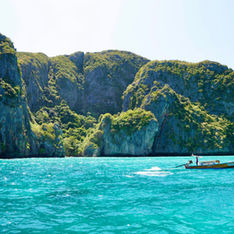Worldschooling in Japan (Summer edition)
- hummblylife
- Jun 29
- 10 min read
Updated: Sep 30

This guide offers insights from a 47 day journey through Japan (7 Weeks), experienced by a family of four (two adults and two kids). While summer is not typically recommended for visiting Japan due to high heat and humidity, it can still be an enjoyable time in such a a fascinating destination.
Japan is an incredible country, rich in history, culture, and unforgettable food! We hope this Guide helps you plan your own version of a learning-filled journey! Click the link below to see the complete guide:
Please note this is only a guide, including ideas and suggestions, which can be paced and adjusted so it is not so packed with activities. After all the goal is not to tire ourselves by getting to as many places as possible; but hopefully to enjoy the journey, to marvel, and wonder, create family memories and go at balanced rhythms of learning/working and resting.
🇯🇵 Trip Planning Essentials
🚅 Trains Book shinkansen and local train tickets easily with the "Smart Ex App"
🏨 Hotels Find great stays on Trip.com and Booking.com
🎟 Tours & Tickets Secure your spots with Klook or GetYourGuide for theme parks, museums, and cultural experiences.
💰 Payments Japan is still very cash-friendly. Carry yen, but IC cards (Suica/Pasmo) and credit/debit cards also work well in some establishments.
📱 Internet Access Get an unlimited data Japan eSIM (e.g., Nomad or Airalo) for easy connectivity.
🚖 Airport Transfers We used express trains or hired a car directly from airport pick up. But if you are traveling with a lot of luggage, we recommend to book a private transfer via Klook or similar platforms for a stress-free arrival.
Highlights
Looking back on our worldschooling journey through Japan, these are some of our favorite—and most meaningful—learning locations. Here are a few we definitely recommend to add to your itinerary:
Kyoto
Despite its growing crowds, Kyoto remains one of Japan’s most culturally rich and rewarding destinations. The Kyoto Imperial Palace grounds provide a peaceful glimpse into Japan’s imperial past, while the Philosopher’s Path invites reflective walks. In Gion, Kyoto’s famed geisha district, visitors can still catch glimpses of traditional artistry and architecture preserved through centuries. And in Arashiyama, skipping the overrun bamboo grove doesn’t mean missing out—nearby spots like the riverside trails offering stunning views and enriching encounters with nature. With careful planning, Kyoto’s timeless charm can still be experienced in meaningful, authentic ways.
When researching for our Japan trip, many advised to have a longer stay in Osaka and do day-trips to nearby cities like Kyoto, Kobe, Nara, etc. While this worked out well for us, you can also consider making Kyoto your base in Kansai, especially if you are not planning to go to Universal theme park and Osaka Aquarium.
Lake Biwa - Daytrip from Kyoto
If you have an international driving license and can rent a car, we highly recommend a day trip to the Biwa lake area. This area is perfect for unwinding and spending quality time with your family surrounded by nature.
🏝️ Omi-Maiko Nakahama Beach This place was truly beautiful and peaceful.
🅿️ Parking
Lunch was nice at this place Shirahige Restaurant
Children Park It's huge! Not the usual playground in a park.
Mount Aso - Daytrip from Fukuoka
Mount Aso is one of Japan’s most fascinating and geologically active destinations. It’s home to one of the world’s largest volcanic calderas, stretching over 100 kilometers in circumference, and features multiple active volcanic peaks—most famously Nakadake, which regularly emits steam and occasional ash plumes. Fun fact: The Aso caldera was formed by massive eruptions over 90,000 years ago and now contains entire towns, farms, and lush grasslands within it!
Nagasaki or Hiroshima Atomic Bomb Museum
Both the Nagasaki and Hiroshima Atomic Bomb Museums offer powerful, deeply moving experiences that highlight the human impact of nuclear war and the importance of peace. Through photos, survivor stories, artifacts, and thoughtful exhibitions, these museums provide essential historical context and a chance to reflect on global issues of war, peace, and resilience.
They are must-visit sites for any Japan trip. However, for families with younger or sensitive children, it’s worth considering taking turns: one adult visits the museum while the other stays nearby with the kids, perhaps at the museum's cafe or park. This way, parents can engage with the material fully, while sharing verbally with the kids in an age-appropriate manner.
Akiyoshidai Cave - Yamaguchi
If you are in the area, don't miss Akiyoshido Cave—it’s truly one of Japan’s most underrated natural wonders. Hidden beneath Yamaguchi’s quiet hills, this massive limestone cave (Japan's largest) stretches over a kilometer with towering chambers, underground rivers, and surreal rock formations. It’s cool, quiet, and awe-inspiring, a perfect break from city crowds and heat. It's absolutely worth the detour.
Hagi - Yamaguchi
Hagi is a coastal town in Yamaguchi Prefecture, rich in samurai history, traditional architecture, and cultural heritage. Known for its preserved Edo-period streets, Hagi Castle ruins, and unique Hagi-yaki pottery. Families can explore old merchant homes, learn about the Meiji Restoration (many revolutionaries came from Hagi), and enjoy quiet coastal walks. It's a slower-paced, educational stop perfect for worldschoolers seeking depth and authenticity off the typical tourist trail.
Miyajima Island - Daytrip from Hiroshima
Miyajima is a natural classroom for history, traditions and environmental awareness—all in one scenic island.
🏯 Cultural Heritage: Itsukushima Shrine is a UNESCO World Heritage Site
🌊 Tides & Nature: Observe how the famous floating torii gate changes with the tides. and observation skills.
🦌 Respect for Animals: Interact with the free-roaming deer and learn about coexisting with wildlife respectfully.
🍡 Local Food & Culture: Try momiji manju (maple-leaf-shaped cakes) and oysters!
Nagoya: Toyota Museum and Ghibli Park
The Toyota Commemorative Museum of Industry and Technology, located near Nagoya Station, is an inspiring and educational stop for families and curious minds. Far more than just a car museum, it traces Toyota’s origins from a textile machinery company to a global leader in innovation. The exhibits are interactive and thoughtfully designed, with massive working machines, hands-on science displays, and detailed timelines that highlight Japan’s industrial growth. It's a great way to learn about engineering, invention, and perseverance. Kids especially enjoy the robotics demonstrations and the mini assembly line models. Whether you're into cars or not, this museum offers a fascinating look at how creativity and technology shape the world around us.
The Ghibli Park near Nagoya is a special stop for fans of the iconic films, offering a nostalgic connection to the animated worlds many grew up with. While it holds a lot of charm, the experience leans heavily toward photo spots and Instagrammable moments—which means long lines and crowds around certain installations. That focus sometimes overshadows the real magic: the detailed sketches, production notes, and behind-the-scenes insights that show just how much talent and effort went into each film. A more immersive, story-driven approach would elevate the experience even more. Still, it remains a must-visit for Ghibli fans, especially kids and adults interested in art, drawing, or animation. Don’t skip the short film screening, it’s a highlight! And the milk and sweet treat near the gift shop? Absolutely worth it. For those closer to Tokyo, there’s also the original Ghibli Museum in Mitaka.
Takayama
Takayama, nestled in the Japanese Alps, is a beautifully preserved town that offers a step back in time. Known for its Edo-period streets, traditional wooden houses, and lively morning markets, it’s a great place to explore Japan’s rural heritage. Just outside the town, the Hida Folk Village brings history to life with over 30 relocated and reconstructed farmhouses, complete with tools, furnishings, and seasonal crafts. The setting is scenic and immersive, perfect for worldschoolers or families interested in architecture and how people lived in old Japan. Together, Takayama and Hida Village offer a rich, hands-on way to experience tradition, surrounded by mountains and local charm.
Takayama Highlights:
Morning Markets – browse local produce, handmade crafts, and snacks.
Try Hida Beef – a regional wagyu specialty, famous for its rich marbling and flavor.
Sample Local Sake – visit traditional breweries in the old town and enjoy free tastings.
Visit Hida Folk Village (Hida no Sato) – explore historic farmhouses and hands-on folk craft displays.
Tour the Takayama Jinya – the only remaining Edo-period government office in Japan, offering a fascinating look at regional rule.
Explore Retro Stores – hidden in side streets, these shops offer vintage toys, Showa-era collectibles, and nostalgic vibes perfect for curious kids and adults alike.
Farm Tomita - Hokkaido
Located in the scenic town of Furano in Hokkaido, Farm Tomita and the nearby Blue Pond (Aoi Ike) offer a magical blend of natural beauty and family-friendly exploration. Farm Tomita is famous for its vibrant flower fields, especially in summer. Just a short drive away, the Blue Pond captivates visitors with its surreal, milky-blue water and standing trees, a landscape that looks almost otherworldly. Together, these two spots provide a peaceful and visually stunning experience—ideal for families wanting to connect with nature, photography, and the changing seasons of Japan’s north.
Noboribetsu - Hokkaido
Noboribetsu, tucked away in Hokkaido’s mountains, is one of Japan’s most famous hot spring towns. The star of the area is Jigokudani (Hell Valley), a steaming, bubbling volcanic landscape that feels like stepping onto another planet. It’s not only visually dramatic, but also a fun and educational spot for kids to learn about geothermal energy and Japan’s onsen culture. Families can enjoy relaxing foot baths, scenic forest walks, and even spot wild deer if you're lucky.
Aomori - Hirosaki
Aomori, though quieter than Japan’s big cities, it’s full of memorable experiences—from the region’s famous apple orchards to its proud local traditions. The Sannai-Maruyama archaeological site offers a rare look into Jomon-era life, while nearby Hirosaki impresses with its well-preserved castle, charming townscape and one of Japan’s most spectacular summer events: the Nebuta Matsuri, with giant illuminated floats parading through the streets. For curious learners, the Seikan Ferry Memorial Ship Museum and Seikan Tunnel Museum dive into the story of Japan’s engineering feat connecting Japan's main island and Hokkaido under the sea.
Highlights:
Aomori Art Museum and Sannai-Maruyama Archaeological Site
Seikan Ferry & Tunnel Museums
Aomori Nebuta Museum WA-RASSE
Hirosaki Castle & Park
Inakadate Rice Paddy Tanbo Art
Hirosaki Apple Park
Matsushima Islands - Sendai
Matsushima, just outside of Sendai in Miyagi Prefecture, is home to one of Japan’s most celebrated scenic views, a bay dotted with over 260 pine-covered islands, each shaped by centuries of wind and waves. While many visitors come for the iconic Matsushima Bay Cruise, the area also offers quiet temples, seaside paths, and glimpses of coastal life. It’s an easy and enriching day trip from Sendai.
Fujiyoshida
Fujiyoshida, located at the base of Mount Fuji, is best known for Fuji-Q Highland, a thrilling amusement park packed with world-record roller coasters and anime-themed attractions (perfect for older kids and teens). But Fujiyoshida also offers a more peaceful side: onsen hot springs with stunning views of Mount Fuji, scenic hiking trails, and traditional streets where you can taste local specialties.
🗻 Fuji Fun Facts:
Tallest in Japan – Mount Fuji is the highest mountain in Japan, standing at 3,776 meters (12,389 feet). Its nearly symmetrical cone makes it one of the most photographed mountains in the world.
A Volcano! – It’s a stratovolcano, last erupted in 1707, and is still considered active.
Three in One – Mount Fuji is actually made up of three volcanoes stacked on top of each other: Komitake, Kofuji, and Fuji.
Inspiration for Art – Fuji has inspired countless works of art, including the famous woodblock print series “Thirty-Six Views of Mount Fuji” by Hokusai.
Lake Neighbors – It’s surrounded by the Fuji Five Lakes—great for hiking, boating, and soaking in hot springs.
Tokyo
And of course—Tokyo! It may appear to be a bustling urban maze that can feel overwhelming at first, but it’s actually a fantastic city for learning and exploration. It’s a great place for kids to practice map-reading, navigating public transport, and taking on small planning responsibilities. Turn the city into a family adventure: set quests like finding the quirkiest vending machines or themed cafés. Don’t miss highlights like teamLab, DisneySea, the many museums near Ueno Station, and the futuristic fun of the Odaiba area. In Tokyo, every train ride and street corner becomes part of the learning experience.
FAQ
Both worked really well!
Whats are must have apps for an android phone that would make traveling easier?
Besides the ones in the screenshot, Google Translate, Google Map and Booking apps are a must. Chatgpt could also work great for translations.
ExpressRide App - used for booking shinkansen
Disney Resort App - if you are planning to visit the theme parks
AQ-Connect was an app I had to download to use the coin-laundry in some of the hotels!
Klook.com - for getting tickets, booking attractions and experiences, we even rented car through the platform.
Wanderlog.com - is a personal favorite to organize itineraries, especially in a country like Japan where you have to pre-book many of the attractions, experiences, museums, and even some restaurants!
Airalo.com - to buy, set up and manage esim
Go Taxi App - we didn't use it much but it was recommended on other blogs for taxis.

Favorite site to book accommodations? Booking.com
Luggage options for Japan?
We highly recommend you pack very light for Japan. We are a family of two adults, two kids and travelled over a month in Japan with two cabin-size suitcases, and each person had a backpack.
How to make our trip budget-friendly?
Accommodation: Opt for family rooms or rental apartments.
Business hotel chains like Comfort or similar often have family options, and platforms like Airbnb or Booking.com can offer apartments with kitchens—great for saving on meals.
Hostels with private family rooms are also a more affordable alternative to hotels.
Be sure to avoid peak seasons like Golden Week (late April–early May), Obon (August), and New Year, when prices can soar.
Transportation: Plan your route carefully. One cost-effective idea is to take the shinkansen to the farthest major city on your itinerary (for e.g. Fukuoka), and then work your way back toward other major city like Osaka or Tokyo. If you have an international driver’s license, consider renting a car for rural areas—especially when traveling as a family, it can save both time and money.
Food: We usually kept it simple for breakfast at our lodging, healthy snacks throughout the day, one main meal, and then the other meal can be convenience store (konbini) food, fruits and supermarket take-out. Many supermarkets offer evening discounts on items like sushi and bento boxes.
For many of our meals, we stuck to budget-friendly family restaurants such as Saizeriya or other local options. Then we’d plan ahead for which days to splurge on a more special meal.
🩷 Hope this is helpful for planning your Japan adventure! 🇯🇵
Follow us on Instagram and feel free to share these resources with friends and family:




















































































































































































































































Comments